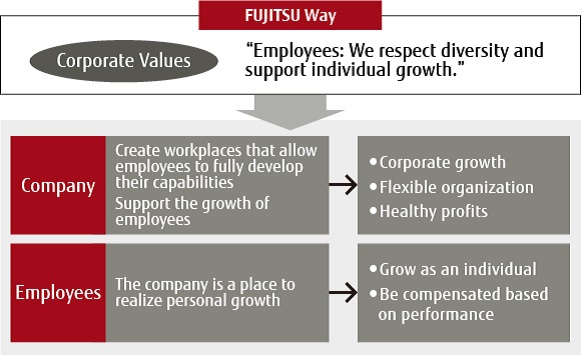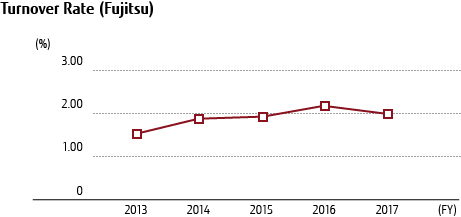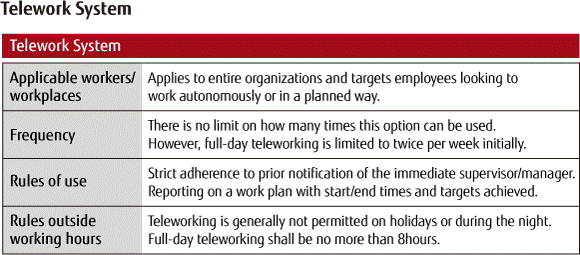Archived content
NOTE: this is an archived page and the content is likely to be out of date.
Creating Good Working Conditions
Human Resources System and Evaluation
Fujitsu’s Approach to Human Resources
The FUJITSU Way corporate philosophy emphasizes that employees are one of the key factors we value and states "we respect diversity and support individual growth”. As a company, we aim for corporate growth, a flexible organization, and healthy profits. To this end, we will create workplaces that support the growth of employees and allow them to fully develop their skills and capabilities. At the same time, employees look to grow as individuals and receive compensation according to their performance, and they regard the company as a place where they can strive to realize their personal growth. Fujitsu manages its human resources based on this approach.

Policies and Objectives
Fujitsu emphasizes "qualitative" fairness in its human resources system, with decisions on employee compensation based on the "level of contribution to the Company" and the "level of results achieved”. For this reason, we disclose information related to human resources.
| ① | Show employees how they can be rewarded with higher compensation | ⇒ | Openly disclose rules of the human resources system |
|---|---|---|---|
| ② | Show how the company evaluates staff | ⇒ | Provide individual evaluation feedback and compensate according to contribution |
| ③ | Show opportunities for challenge | ⇒ | Human resource development, internal postings, Free Agent program |
In Japan, Fujitsu has introduced a "human resources system based on functional division and competency grade”. Under this system, which forms the basis for human resources compensation, we define "functional division" as the function the employee should be fulfilling and "competency grade" as the ability to achieve a specific performance that can be linked to a business outcome.
Under this human resources system, we clarify the competency grade requirements of employees in a job description for each functional division. Through periodical reviews of the competencies that each person demonstrates, we aim to support the growth of all employees over the medium and long terms.
Goals
- Continue raising the competencies so that each employee can gain a sense of growth.
- Provide incentives for pride and awareness to those who deliver high added value.
- Reward those who make constant efforts toward growth.
We aim to ensure that the actions described above are implemented on an ongoing basis throughout the company.
Detailed Structure
We conduct evaluations of "initiatives aimed at medium-to-long-term growth" and "maximizing results in the current financial period." To reflect these in compensation, we use a two-pronged evaluation mechanism based on competency evaluations and performance evaluations. The results of the competency evaluations are reflected in salary increases and grade changes, and the results of performance evaluations are reflected in bonuses.

- We conduct activity-based evaluations of the degree to which employees demonstrate "appropriate mindset", "business execution ability" and "specialist expertise", and then take into account the relative gap to upper-level grades before determining the overall evaluation.

- By separating medium-to-long-term factors from the process, we are able to conduct more clear-cut evaluations based on the scale of half-year results.
In addition, we continue to support efforts aimed at the medium-to-long-term growth of each employee. With a focus on career goals, we also encourage interactive communication between employees and their managers that covers the areas of behavioral change and medium-to-long-term growth. Review meetings are conducted annually at the beginning of each year.
Furthermore, we have started formulating a globally unified role framework, as well as evaluation standards and evaluation cycles.
Establishing the Right Environment
So that each and every one of our employees can work efficiently to create even higher added value, Fujitsu is endeavoring to create a workplace environment that supports a diverse range of employees. This includes the introduction of a telework system and options for employees whose circumstances involve child care or nursing commitments.

- Fujitsu Telework System
In April 2017, Fujitsu formally introduced a telework system that allows for flexible ways of working that are not tied to a specific location. This system is available to all 35,000 Fujitsu employees in Japan and includes working from home or a satellite office as well as working during business trips.
The introduction of the system was preceded by a series of explanatory briefings.

・Goals of the system
- To boost individual productivity and maximize the benefits of team work
- To build an environment that supports continued participation by a diverse range of staff
- To ensure business continuity and rapid responses to disasters
- Arranging Systems to Support Pregnancy and Child Care
In regards to pregnancy and child care, we have established and implement our action plans*1 in accordance with the Law for Measures to Support the Development of the Next Generation. In addition, we provide babysitter subsidies, and in FY2018 we will add two in-house childcare facilities to our sites, bringing the total to three facilities. Furthermore, we conduct a forum to assist and help build networks for employees who have just returned to the workplace after child care leave.
In FY2017, we continued hosting forums for Fujitsu and Group company supervisors who manage employees with children, as well as forums for Fujitsu and Group company employees who have returned to work during the past year after taking maternity or childcare leave. Since FY2016, qualifying workers have been required to attend returning workers’ forums, which have included health advice from public health nurses, presentations by female executives with experience in child-raising, and talks and group discussions with external speakers.
The number of forums being held for company supervisors who manage employees raising children has been increased to promote better management of diversity. These forums have served as a venue for talks by the Health Promotion Division on the particular needs of female employees raising children, as well as group discussions and talks on management-related issues by invited speakers.
As a new initiative in FY2016, we also held a ‘Seminar on understanding infants and employees responsible for infants’ focusing on infant illnesses and injuries, with practicing paediatricians attending as guests. It was recommended that employees raising children attend this seminar together with their immediate managers to promote mutual understanding in the workplace.
*1 Action plans:
Fujitsu has implemented action plans from 2005, and is now implementing the sixth action plan (April 1, 2018, to March 31, 2021).- 6th Action Plan (96KB) (Japanese content only)

We formulate action plans based on Japan's Law for Measures to Support the Development of the Next Generation in Japan. Among companies that have acquired the "Kurumin" certification mark, we received "Platinum Kurumin" certification in November 2015 from the Minister of Health, Labour and Welfare, for our advanced initiatives in balancing life and work.
- Nursing Care
In November 2017, during Nursing Care Week, Fujitsu conducted a seminar on balancing work and nursing care. We also redesigned seminars trialed in the previous year to create internal and external support systems and prepare employees for their nursing care commitments. These seminars included a Basic Session (to gain basic knowledge, such as preparation for nursing care) and a Care Manager Session (to gain hints and learn from the experiences of care managers active in nursing care facilities). In addition, we held multiple seminars for managers on the topic of dealing with staff facing nursing care commitments and how they should provide support from a managerial perspective.
Number of Employees Using the Care Leave Support System (FY 2017, Fujitsu Limited) System Total*2 Men Women Child care leave 425 42 383 Family care leave 7 4 3 Reduced working hours (child care) 871 21 850 Reduced working hours (family care) 13 6 7 Paternity leave 652 652 - *2 Numbers of Users:
Numbers of Users: Figures include employees who have continued to use the system from the previous fiscal year. The percentage of employees who return to the workplace after taking child care leave is nearly 100%, for both men and women.Return to Work Rate/Continuous Work Rate after Child Care or Family Care Leave (FY 2017, Fujitsu Limited) System Return to work rate Continuous work rate*3 Child care leave 98.4% 98.3% Family care leave 100% 92.3% *3 Continuous work rate:
The proportion of employees continuing work 12 months after returning from child care leave or family care leave. - Holding a Variety of Forums
We are implementing a variety of forums to improve both productivity and individual job satisfaction and fulfillment based on the many different ways people work with the theme "Reforming the Way We Work."
We focused on understanding differences in ideas through FY 2009, and since FY 2010, we have been implementing training based on concrete, practical measures. In FY 2015, we held forums in the Keihin region, focusing on the theme of remote nursing care, to call appropriate attention for both work and nursing care needs. These forums consisted of talks and group discussions and were intended to give all employees an opportunity to develop their understanding of job approaches, and make immediate changes, that would allow them to balance nursing care and work, and continue working with a sense of worthwhileness.
In FY2016, Fujitsu held workshops on the topic of work style reform through digitalization. The venue for these workshops was the FUJITSU Digital Transformation Center, which offers the very latest in ICT. Employees from various divisions took part in the workshops and were involved in discussions on ways to further boost productivity by adopting more diverse work styles.
In FY2017, we invited lecturers from outside Fujitsu to host a telework-related seminar on July 24, designated as Telework Day. The seminar was aimed at encouraging utilization of our telework system and other systems for realizing diverse work practices. Furthermore, during Telework Week in November 2017, we invited experts from outside the Company to run multiple seminars highlighting specific ways to utilize our telework system.
- FUJITSU Digital Transformation Center: http://www.fujitsu.com/global/about/corporate/facilities/dtc/
Initiatives Aimed at Reducing Long Working Hours
The Fujitsu Group aims to improve the work-life balance and the productivity of every employee through a variety of initiatives aimed at reducing long working hours. As an example, at Fujitsu Headquarters, every Wednesday is designated as a day for leaving work on time. On these days, the company turns off lights at 6:00 p.m. to encourage employees to return home.
Examples of specific initiatives aimed at improving long working hours
- Adoption of flex time, a discretionary labor system for professional work, and a discretionary labor system for management-related work
- Sending of alert e-mails for overtime work
- Not scheduling meetings outside of scheduled working hours
- Setting of recommended days for taking annual leave
- Enforcement of leaving work on time one day a week
- Leaving work one hour earlier every day
- Enforcement of working hours management in management training
- Promotion of a telework system aimed at diverse work practices
- Adjustment of work style and rest style according to busyness of work
Employee Benefits Program
The Fujitsu Group has programs in place that are suited to the life styles of employees and strive to allow them and their families to lead healthy and prosperous lives.
In order to respond to the advance of globalization and diversity and to the changing needs of employees, in October 2014 Fujitsu introduced the “F Life+” cafeteria plan*4 as a new employee benefits program.
In addition to this, under the idea that active work and growth by every employee leads to the growth and development of the company, we have established a variety of initiatives to support employees' own efforts at preparations for the future, including savings/property accumulation programs, an employee shareholding association, group insurance benefits, housing support, medical support, health support, and child support.
*4 Cafeteria plan:
A system by which employees select desired or needed employee benefits from a diverse menu prepared by the company, taking advantage of the options in the form of using up "employee benefits points" granted by the company.
Measures to Energize Communication
Labor Relations
Based on labor-management agreements with the Fujitsu Labor Union, Fujitsu holds discussions about various employment conditions and explains management policies and business conditions, along with business reorganization and other matters, to its employees through regular and ad hoc meetings such as the Labor Council or Productivity Council. Furthermore, these agreements stipulate the collective bargaining rights of the union.
Note that since Fujitsu adopts a union shop system, all non-managerial employees are members of the Fujitsu Labor Union. (The Fujitsu Limited Labor Union membership rate 77.09%*5).
In Europe, the Fujitsu European Annual meeting has taken place every year since 2000, with the overall financial conditions of the Fujitsu Group and other issues shared with the employee representatives from Fujitsu Group companies.
*5 Union participation rate:
The 77.09% figure quoted is the ratio of non-managerial employees out of all full-time employees (including managers).
Activities for Employees in China to Strengthen the Protection of Personal Information
Laws aimed at strengthening protections for personal information are being drafted and enacted in rapid succession and last year Japan saw the implementation of the Cybersecurity Law (20170601), the General Principles of the Civil Law (20171001) and the Personal Information Security Specification (20180501). Japan-based companies are also expected to comply with such regulations in their global operations. In specific terms, companies must impose restrictions on the scope of use of personal information and they must acquire from employees individual agreements on the use of such information.
In November 2017, discussions were held as part of a working group involving the human resource departments of Fujitsu Group companies related to business in China. The focus was on the scope of impact, countermeasures, and so on relating to legal system developments. After confirming the status of personal information management and control in the various Group companies, we determined to create for all Group companies in China a uniform Personal Information Handling Agreement Form and to implement a standardized Group-wide Personal Information Protection Management System.
In the future, we will continue to comply with relevant laws and regulations as we strive to use and manage personal information in an appropriate manner, thereby reassuring employees and creating a workplace that is easy to work in.
Establishment of a Consultation Service for Human Resource Programs, etc.
Fujitsu established a consultation service as a contact point for e-mail and phone calls to the Human Resources and Administration Units, as we work to build a structure that makes it easy for employees to seek guidance on human resource and administrative programs.
Employee Satisfaction Survey
In order to continue as "an organization wherein all employees are strongly motivated, have ample opportunities for advancement and work with pride and confidence" in accordance with the Fujitsu Way, the Fujitsu Group conducts employee satisfaction surveys that provide opportunities for serious thinking about ways by which management in each organization can improve employees' motivation.
We have been gradually introducing our Employee Engagement Survey in Japan since FY2002, and outside Japan we began conducting the survey across all our overseas Group companies in FY2011. In FY2017, the survey targeted around 80,000 employees at 76 Group companies in Japan (including some 35,000 Fujitsu staff), while 41,000 overseas employees were surveyed, primarily at key Group companies. A total of 100,000 Japanese and overseas employees responded to the survey. The survey response rate was 87% in Japan, 75% overseas, and 83% globally.
We use this survey to both compare regions within the Fujitsu Group and also benchmark ourselves against our competitors in each country and region. Based on analysis of the results, we have identified issues specific to countries and regions, and to divisions and occupations, and are now working toward improving management and reforming our organizational culture.
Response Trends
Questions relating to engagement, such as “I feel proud to work for Fujitsu” attracted positive responses from 60% of our employees, with a 58.9% result from male employees and a 61.5% result from female employees.
In Japan, we are making steady progress with improvements aimed at creating worker-friendly workplaces, evidenced by more positive responses to comments such as "The company supports me in achieving a reasonable balance between my work life and my personal life", "I am treated with respect as an individual" and "My immediate manager is supportive and helpful”. Overseas, responses related to "Empowerment" rated highly and initiatives aimed at realizing a company in which every employee can work with pride and motivation are beginning to bear fruit.
